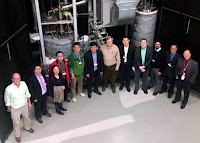China, in partnership with the U.S. Department of Energy, says it will deploy advanced nuclear reactors commercially by 2030
A group of nuclear scientists and entrepreneurs gathered this week at Oak Ridge National Laboratory, in Tennessee, to observe the 50th anniversary of the molten-salt reactor experiment—a program carried out at Oak Ridge in the 1960s to build a novel nuclear reactor. Molten-salt reactors use liquid, rather than solid fuel rods, as the fuel to produce the nuclear reactions that heat water to make steam and, in turn, electricity. They have several advantages over conventional light-water reactors in terms of safety, anti-proliferation, and economics, and are enjoying a renaissance as the world searches for sources of low-cost, low-carbon energy.
The 50th anniversary workshop, which included presentations from reactor developers including TerraPower, Flibe Energy, Moltex Energy, and Terrestrial Energy, as well as the large utility Southern Power, marked the largest and most significant gathering to date of the people working to bring this innovative yet decades-old technology to commercialization.
Among the presenters was Xu Hongjie, the director of the molten-salt reactor program at the Shanghai Institute of Applied Physics. Under the auspices of the Chinese Academy of Sciences, SINAP is collaborating with Oak Ridge to advance research on both salt-cooled reactors (which use molten salts to transfer heat and to cool the reactor) and salt-fueled reactors (in which the fuel, where the energy-producing nuclear reactions occur, is dissolved within the salt coolant). Signed in December 2011, the Shanghai-Oak Ridge effort has been the subject of controversy and speculation among the nuclear power community, particularly those promoting advanced technologies such as molten-salt reactors and the use of thorium, an alternative nuclear fuel that is cleaner, safer, and more abundant than uranium.
At Oak Ridge this week, Xu outlined a roadmap that shows that China is further along than any other advanced reactor R&D program in the world. China, which still gets nearly three-quarters of its electricity from burning coal, is racing to develop low-carbon energy sources, including both conventional nuclear plants and advanced systems such as molten-salt reactors. The largest emitter of greenhouse gases in the world, China aims to more than double its nuclear capacity by 2020, according to the World Nuclear Association.
Read more at China Details Next-Gen Nuclear Reactor Program

No comments:
Post a Comment